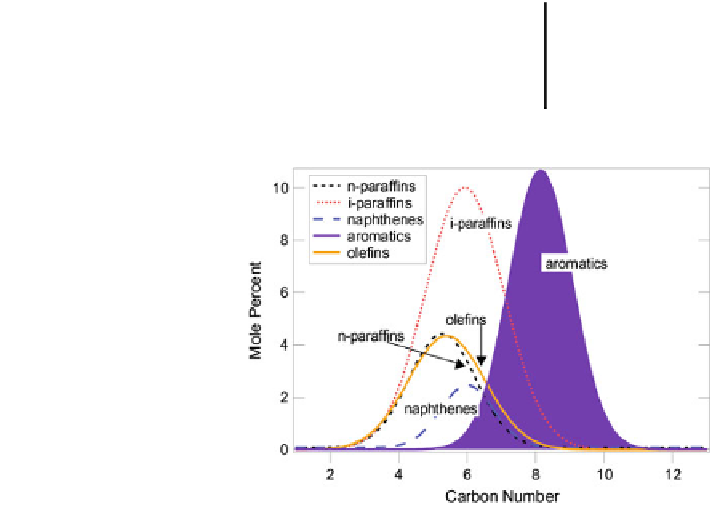Environmental Engineering Reference
In-Depth Information
Table 2 Typical diesel fuel
components (Farrell et al.
2007
)
Component
(v %)
Normal and isoparaffins
25
50
-
Cyclo-paraffins
20
-
40
Aromatics
15
-
40
Fig. 2 Typical gasoline
composition showing
concentration by chemical
classes (adapted from Tsang
2003
)
compositions that can vary depending on the nature of the crude, time of year, and
the re
nery (Farrell et al.
2007
). The result is that fuels produced from different
production runs or re
neries may not have precisely the same properties.
The multicomponent characteristic of real fuels makes it a signi
cant challenge to
develop the required inputs for simulation, including predicting the phase equilibrium
behavior, properties, and combustion kinetics as noted above. The problem is further
exacerbated by the new generation of biofuels about which much effort has been
devoted to production but little to evaluating combustion performance.
The only viable approach to simulating combustion performance of real fuels in
engines is to develop a
ned as a blend of
relatively fewer compounds of known chemical species and mixture fractions which
are selected to match certain thermochemical aspects (
“
surrogate
”
for them. A surrogate is de
)
1
of the real fuel
(Dooley et al.
2010
,
2012
; Liu and Avedisian
2012
; Zhang et al.
2007
; Mueller
et al.
2012
; Narayanaswamy et al.
2013
; Pitz and Mueller
2011
). With appropriate
blending and mixing strategies, the surrogate may replicate most (but often not all)
of the combustion targets around which it is developed. It is advantageous that the
number of constituents of the surrogate blend should be as low as possible in order
to make tractable the prediction of properties and phase equilibrium behavior, as
well as to develop combustion chemistry. The simplest surrogate would be a single
“
targets
”
1
A combustion
is de
ned here as a variable used for matching a surrogate with a real fuel
(e.g., molecular weight, derived cetane number, liquid density). A combustion
“
target
”
“
property
”
is
de
ned as a variable measured in a combustion con
guration.







Search WWH ::

Custom Search